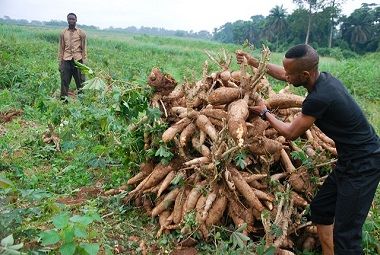Researcher Gives Better Ways To Farm Yam


The demand for yam in Nigeria is usually very high, making it one of the Nation’s most valuable tuber crops. Every part of the country harvest yam and sometimes have festivals to celebrate their harvest of a new yam season.
The Minister for State, Federal Ministry of Agriculture, Senator Heineken Lokpobiri, said at the launch of the maiden set of improved certified seed yams (a 5-year $12 million research programme funded by the Bill and Mellinda Gate Foundation to improve yam seed) last year in Abuja, that yam is cultivated on 3 million hectares of land annually with the certified seed yam capable of generating N2.4billion if sold for N20 each.
Dr. Nwaogu Edward Ngozi, Head of Station, National Root Crops Research Institute, Nyanya Sub-Station in Abuja, advised farmers to take note of important factors before planting yam.
- Site Selection: He stated that yam grows well on upland soils. Being a high nutrient demanding crop, yam requires a soil that is deep, free draining, and relatively high to medium in fertility with loamy sand or clay loam characteristics. Good soil drainage is essential for optimum yields of the crop. Heavy clay soils tend to water-log in the rainy season and are liable to cause tuber rot. Infertile soils are not recommended for yam production because such soils are unable to retain sufficient water or nutrients to produce reasonably-sized tubers. Also, soils that have high amounts of gravels or stones are unsuitable as they constitute a barrier to tuber penetration and root anchorage.
- Land Preparation: For optimum yield performance, planting is usually done on mounds or ridges. The size (height) of the mounds varies from 30 cm to as high as 100 cm depending on yam variety, locality, targeted tuber size and culture. However, planting yams on ridges instead of on mounds offers a greater opportunity for increased seed rate and ensures optimum utilization of land resources for sustainable tuber production. In most traditional farming systems in Nigeria, yam is planted on flat. This practice is common among people from Abia, Edo and Delta. In such systems, holes are made in rows and yam seeds are planted without the soil being heaped on top.
- Planting: Dr. Nwoagu stressed that yam can be propagated as ware yam or as mini-sett, depending on the objective of the planting and size of seed yam tuber required. In Nigeria, farmer-saved seeds are the predominant source of planting material. For production of reasonably large tubers, large ware tubers of about 2 -3 kg are cut into smaller sett size, ranging from 300g to about 600 g. These setts are then planted to produce normal seed yam tubers weighing one kilogram and above. This method reduces substantially the quantity of tubers that could be used for food because when seed-sized tubers are in short supply, larger tubers are converted to seed yam by being cut into setts. Cut yam setts of about 20 – 50 g size can be used to produce seed yam tubers using the yam mini sett technology introduced by NRCRI Umudike and IITA. In cutting yam into plantable seed setts, care should be taken to ensure that the cut sett possessessubstantial amount of the peel from which sprouting can occur.
Yam is planted at a recommended distance of 1 m x 1 m for (ware yam production) while closer intra-row spacing of about 20 – 40 cm is required for smaller setts. Yam planting is done by placing the skin of the cut sett in close contact with the soil and covering with soil. For dry season planting, mulching with dry grasses to conserve soil moisture and protect the sett from harsh sunlight and heat is very important.
- Field Maintenance:The researcher said that for sustainable yield of yam, timely routine maintenance of the yam field is important. Operations such as weeding, staking, fertilization, earthening up and erosion control should be embarked upon and on time too. These operations have critical influence on yam tuber response and the ability of the crop to assess essential growth nutrients from the soil. Best yields are obtained when weeding is done as frequently as they grow up in the yam plot. Fertilization is best done at 8- 10 weeks after planting. Fertilizer application is by banding. For low fertility classed soils, 400-500 kg/ha of inorganic NPK 20:10:10 fertilizer is regarded as adequate for optimum yield of yam. However, complementary application of inorganic NPK fertilizers with organic manures such as poultry dropping and animal waste enhances fertilizer use efficiency of the crop and maximizes tuber yield response.
- Harvesting: He said maturity in yam is attained after 6 – 12 months of growth of the crop. At maturity, the leaves turn pale yellow and gradually dry up. This is quickly followed by dryness of the yam vines. Harvesting can be either double or single harvesting. Single harvesting is done by harvesting the matured yam tubers whole i.e. without leaving any part thereof inside the soil. Double harvesting is done by carefully removing newly formed tubers from the “corm region” while leaving the roots intact to form another tuber in place.
- Storage: After harvesting, the researcher advised farmers to allow the yam tubers under shade for 2 – 3 days for curing to take place. Curing refers to a situation where the tubers are placed in a condition that allows the heat and water generated during harvesting to dry up on the surfaces of the tubers in order to initiate the process of healing. Proper storage of yam is an essential step in yam production. Improper storage causes tuber rot and dehydration and thus resulting in post-harvest loses.A good storage facility must allow proper circulation of air within the environment where the tubers are stored; protect the tubers from direct contact with rain or sun light capable of facilitating microbial breakdown of the tubers; be cool and free from materials likely to introduce degrading micro-organisms; and must be large enough to adequately contain the volume of tubers to be stored.










